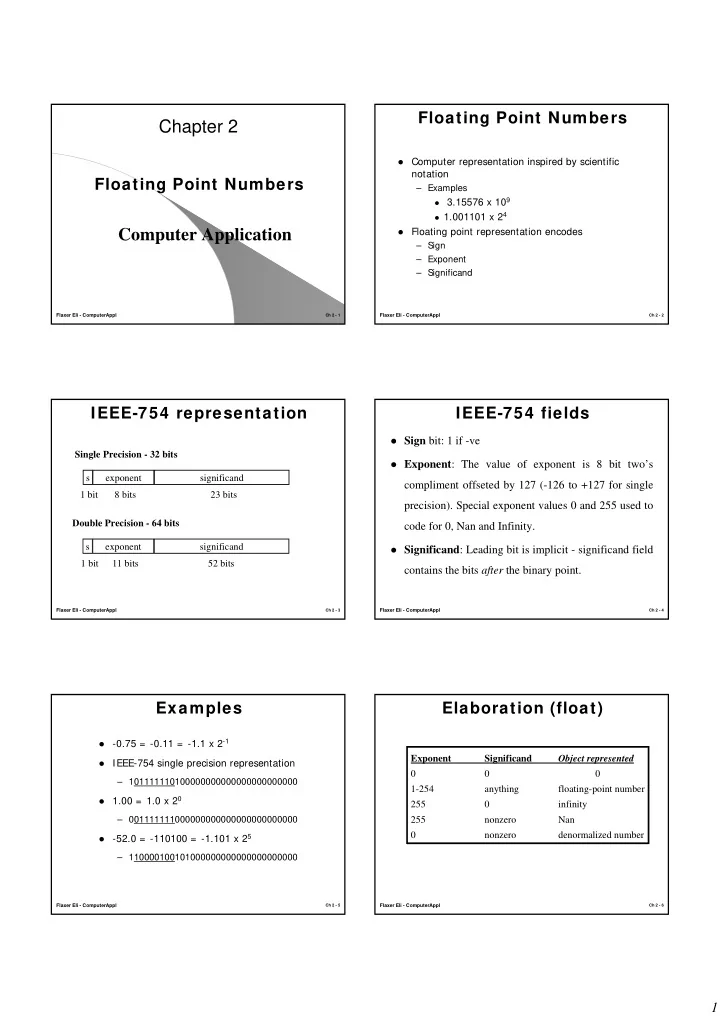

Floating Point Numbers Chapter 2 � Computer representation inspired by scientific notation Floating Point Numbers – Examples � 3.15576 x 10 9 � 1.001101 x 2 4 Computer Application � Floating point representation encodes – Sign – Exponent – Significand Flaxer Eli - ComputerAppl Ch 2 - 1 Flaxer Eli - ComputerAppl Ch 2 - 2 IEEE-754 representation IEEE-754 fields � Sign bit: 1 if -ve Single Precision - 32 bits � Exponent : The value of exponent is 8 bit two’s s exponent significand compliment offseted by 127 (-126 to +127 for single 1 bit 8 bits 23 bits precision). Special exponent values 0 and 255 used to Double Precision - 64 bits code for 0, Nan and Infinity. s exponent significand � Significand : Leading bit is implicit - significand field 1 bit 11 bits 52 bits contains the bits after the binary point. Flaxer Eli - ComputerAppl Ch 2 - 3 Flaxer Eli - ComputerAppl Ch 2 - 4 Examples Elaboration (float) -0.75 = -0.11 = -1.1 x 2 -1 � Exponent Significand Object represented � IEEE-754 single precision representation 0 0 0 – 101111110100000000000000000000000 1-254 anything floating-point number 1.00 = 1.0 x 2 0 � 255 0 infinity – 001111111000000000000000000000000 255 nonzero Nan 0 nonzero denormalized number -52.0 = -110100 = -1.101 x 2 5 � – 110000100101000000000000000000000 Flaxer Eli - ComputerAppl Ch 2 - 5 Flaxer Eli - ComputerAppl Ch 2 - 6 1
Why Offset C Examples #include <conio.h> #include <stdio.h> � To keep the order in integer form. union dami { float f; � If (x > y) < = > (int)x > (int) y. long l; } tt[4]; Comparing integer is faster and simpler. � void main() { � Example: FILE *fp; fp= fopen ("xxx.txt", "w"); 2.0 = 010000000000000000000000000000000 clrscr(); With Offset tt[0].f = 1.0; 0.5 = 001111110000000000000000000000000 Result: tt[1].f = -1.0; tt[2].f = 0.0; 3f800000 tt[3].f = 1.25; 2.0 = 000000001000000000000000000000000 bf800000 No Offset fprintf(fp,"%08lx\n", tt[0].l); 0.5 = 011111111000000000000000000000000 fprintf(fp,"%08lx\n", tt[1].l); 00000000 fprintf(fp,"%08lx\n", tt[2].l); fprintf(fp,"%08lx\n", tt[3].l); 3fa00000 } Flaxer Eli - ComputerAppl Ch 2 - 7 Flaxer Eli - ComputerAppl Ch 2 - 8 Floating Point Addition Floating Point Adder Sign Exponent Significand Sign Exponent Significand Start 1. Compare the exponents of the two numbers. Compare Shift the smaller number to the right until its Small ALU exponent would match the larger exponent exponents Exponent 2. Add the significands difference 0 1 0 1 0 1 3. Normalize the sum, either shifting right and incrementing the exponent or shifting left Shift smaller and decrementing the exponent Control Shift right number right Yes Overflow or Add underflow? Big ALU No Exception 0 1 0 1 4. Round the significand to the appropriate number of bits Increment or Normalize Shift left or right decrement No Still normalized? Rounding hardware Round Yes Flaxer Eli - ComputerAppl Ch 2 - 9 Flaxer Eli - ComputerAppl Sign Exponent Significand Ch 2 - 10 Done Floating Point Multiplication IEEE-754 Rounding Start 1. Add the biased exponents of the two numbers, subtracting the bias from the sum to get the new biased exponent Two extra bits, guard and round, are maintained in � intermediate results to do rounding properly. 2. Multiply the significands � Rounding options 3. Normalize the product if necessary, shifting it right and incrementing the exponent – Truncation Yes – Round up Overflow or underflow? – Round Down No Exception 4. Round the significand to the appropriate – Round to nearest number of bits No Still normalized? Yes 5. Set the sign of the product to positive if the signs of the original operands are the same; if they differ make the sign negative Done Flaxer Eli - ComputerAppl Ch 2 - 11 Flaxer Eli - ComputerAppl Ch 2 - 12 2
Finite Precision Arithmetic � IEEE-754 only captures a finite number of members of the infinite set of reals � Floating point operations produce approximate, not exact results this can have profound consequences when you want to perform a long sequence of arithmetic operations. Egs weather prediction, nuclear weapons simulations. Flaxer Eli - ComputerAppl Ch 2 - 13 3
Recommend
More recommend